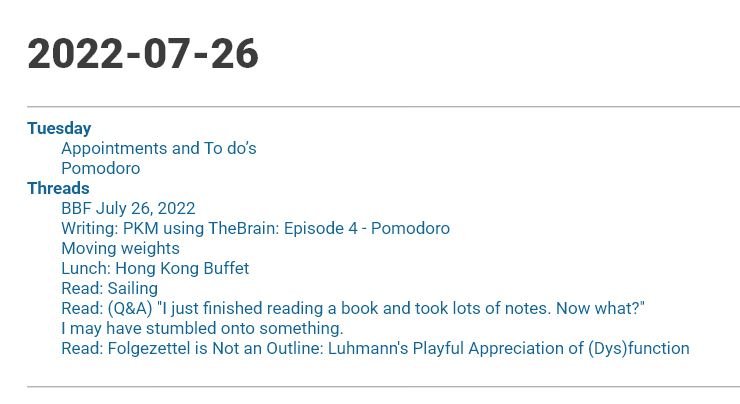During the last two episodes of the Personal Knowledge Management series using TheBrain, we discussed specific layouts of the daily note structure. In Episode 3, we reviewed the section “Today,” and in Episode 4, we discussed some benefits of using the Pomodoro Technique in our daily routine.
While Episodes 3 and 4 are predominately record keeping in nature, Episode 5 is where the magic happens in my daily note structure, and I call this section “Threads.” The term “threads” is short for “Discussion Threads,” or another phrase I like is “strings of thought “[1] or simply “thought strings.” All iterations are designed to remind me that perhaps I have had this thought or similar thoughts before. I’ll explain.
In “The Majesty of Books,” Stirling W. Sill notes that Ralph Waldo Emerson “wrote down his every thought.”
“Each day he collected in his journal his disjointed dreams, his mental reveries, and the fragments of all of those ideas that his mind was able to conceive.” [2]
Mr. Sill further noted that Emerson would review his thoughts repeatedly, making needed improvements until he could join them together in the most effective order. This idea of collecting “disjointed dreams” so intrigued me that I kept a journal and tried to collect my thoughts on paper.
I’ve already bored readers with a detailed review of my move from handwritten journal entries to digital and my subsequent three-year attempt to apply the Zettelkasten methodology to TheBrain. We will review my lessons learned in a future episode. Suffice it to say that connecting the dots on past thoughts is not as easy as it sounds.
The “Threads” section of my daily note structure attempts to collect and connect my disjointed dreams and mental reveries. I’ve found that three things are required to make the connections viable:
Title
I prefer to use the four hashtag headline format (####) to have the title captured in the Table of Contents section at the beginning of each day. The Table of Contents allows for quick review. The title should be concise and “encapsulate the idea of the note.” [3] In the Zettelkasten world, treatises are written regarding how to title a subject. Under the threads banner, we are looking for fast and easy. Refactoring the title can occur at a later date if necessary.
Unique ID
Unique IDs are also the cause of much debate. The simple fact is that “without fixed IDs and positions, [a] note would be lost.” [4] We need a way to connect the dots; to accomplish this, a UID is required. Which form of UID is up to you; however, pick a strategy and stick with it. Changing the UID form is time-consuming and frustrating. Niklas Luhmann used a form of alphanumeric system in his Zettelkasten methodology. Others use a metadata code to capture all kinds of information. I use a simple YYYYMMDDTTTT format to capture the date and time I created the thought. UID is a personal choice; however, choose wisely according to your use case.
Note
Capture the information.
If you’ve read Sonke Ahrens’ book, “How to Take Smart Notes,” these scribbled thoughts are the essence of a “fleeting note.” [5] The goal here in the “Threads” section is to capture first by creating a form of “index to [your] life.” [6] Then, see if anything you caught can be connected or expanded. A quick look at my Table of Content from July 26, 2022, will give you an idea of the types of items I like to capture under “Threads.”
In Episode 6, we will explore ways to connect our captured ideas using TheBrains primary features of “hard links,” i.e., parent, child, or jump thoughts. “Soft links” or hyperlinks. I refer to hyperlinks as soft because a hyperlink can break by accidental deletion. And finally, using the search feature and UIDs.
—-
Reference:
[1] Gescho (2019, September 4). Retrieved from https://zettelkasten.de/posts/lattice-of-thoughts/
[2] Sill, S. W. (1974). The majesty of books. Salt Lake City, UT: Deseret Book. p.182.
[3] [How to tie the title with the note's idea — Zettelkasten Forum](https://forum.zettelkasten.de/discussion/1864/how-to-tie-the-title-with-the-notes-idea)
[4] Thomas, E. (2020, August 23). Understanding Zettelkasten - What it means to communicate with the slip-box. Retrieved September 11, 2020, from https://medium.com/@ethomasv/understanding-zettelkasten-d0ca5bb1f80e
[5] [What is a Fleeting Note? | The Daily Pony (bobdoto.computer)](https://writing.bobdoto.computer/what-is-a-fleeting-note/)
[6] [Practically Paperless with Obsidian, Episode 15: Daily Notes as an Index to My Life – Jamie Todd Rubin (jamierubin.net)](https://jamierubin.net/2022/01/25/practically-paperless-with-obsidian-episode-15-daily-notes-as-an-index-to-my-life/)


